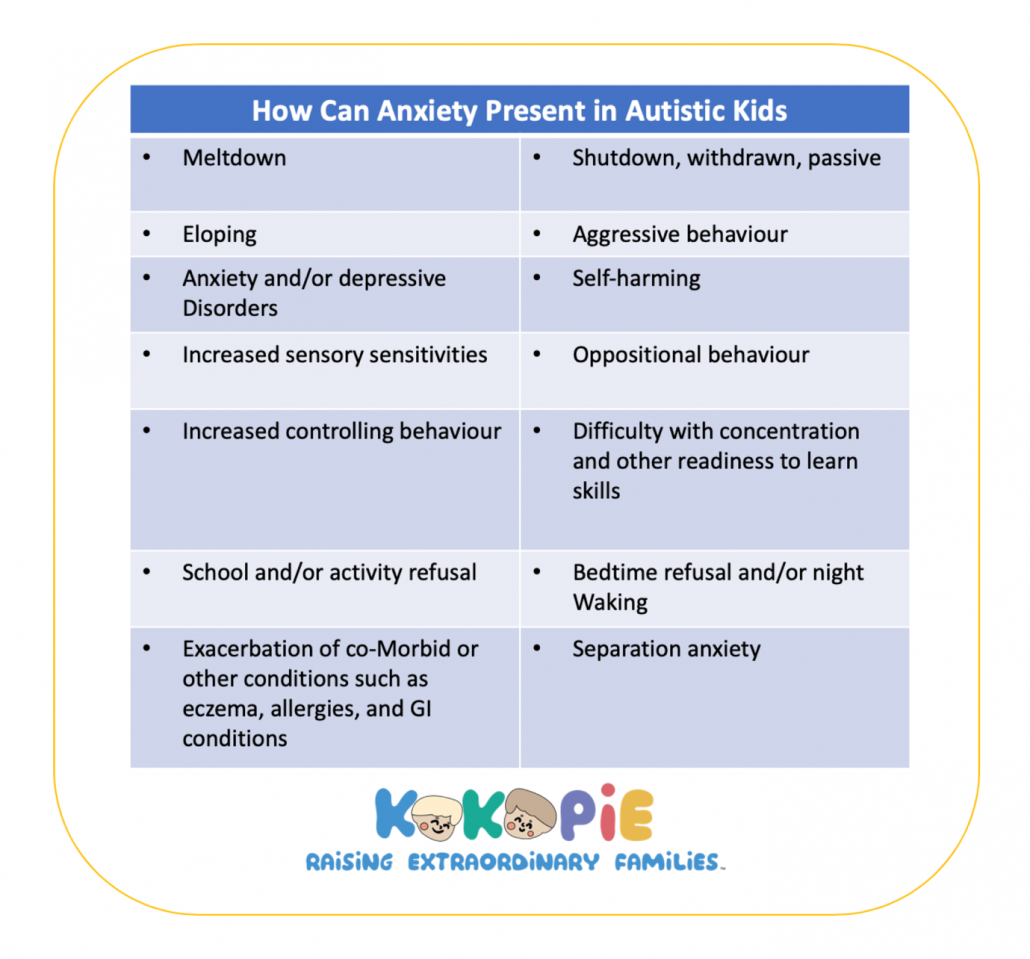How Anxiety Can Present in Autistic Children
30th April 2020
Share this entry:
How Anxiety Can Present in Autistic Children
Anxiety is not Autism – KoKoPie
What is Anxiety?
Anxiety is a feeling of distress that can be mild or severe. This emotional response by a child is to a detected or perceived danger. Therefore, a child experiencing anxiety is moved into a protective mode. We call this mode the fight-or-flight or even freeze mode.
Autistic Children and Anxiety:
Being autistic describes the way a child communicates and interacts with their environment and people around them. It is one of the neurotypes, or types of brains, that make up human diversity.
It is important to note that anxiety is not part of autism.
This point is often confused since so many autistic children experience anxiety. And their experience with anxiety comes from a large variety of reasons. Some reasons may include a lack of social acceptance, sensory over-whelm, social anxiety, a co-morbid learning disability, and their communication being misunderstood by others.
Anxiety greatly impacts a child’s health and overall well-being. All children may display these behaviours related to anxiety but autistic children may do so more frequently or with greater intensity. Learning how anxiety presents in autistic children is a great step to identifying anxiety triggers and creating support.
What Does Anxiety Look Like in Autistic Children?
There are many ways that anxiety can present in autistic children. The above infographic lists some of the most common ways.
Meltdowns: A meltdown is an outburst due to a child feeling overwhelmed by his/her feelings or environment. This reaction is to something typically beyond a child’s control.
Eloping: Wandering or ‘running away’ from a caregiver or environment. A child may elope to stretch their legs or explore. Elopement can also be a tactic a child turns to when in the ‘flight’ mode of ‘fight-or-flight’ from a distressing trigger. In this case, the child will be looking to escape an upsetting situation or environment. If a child is eloping under stress, he/she may not be aware of their safety when doing so. This is of particular concern near car parks, roads, or water.
Anxiety and/or Depressive Disorders: Ongoing stress can manifest into a mental health condition.
Increased Sensory Sensitivities: Many autistic children have Sensory Processing Disorder (SPD). SPD describes differences in how a child receives and responds to information that comes through the senses. A child may over or under respond to a sensory stimulus. Lights may be too bright, noises too loud, or skin less able to feel temperature or pain.
Increased Controlling and Oppositional Behaviour: Feeling in control can help an autistic child feel safe. It’s a coping mechanism to help them know what will come next. It’s really quite a clever way of helping themselves avoid upsetting triggers.
School and/or Activity Refusal: Attending school and activities with other children comes with a lot of unknowns, social pressures, and sensory bombardment. Refusal may come in the form of verbal refusal, refusing to get ready, excuses like feeling ill, or digging their heels in when at the doorway of the school/activity.
Exacerbation of Co-Morbid or Other Conditions: When stressed and anxious, a child’s immune system is lowered and the inflammatory system is heightened. This creates an environment for any co-occurring conditions to flare up. Examples of co-occurring conditions may be eczema, gastrointestinal (GI) conditions, asthma, and allergies.
Shutdowns: We often think of meltdowns as explosive, but children can turn all of that anxious energy inward too. They can shut down. The child may become withdrawn, passive, quiet, or struggle to make decisions.
Aggressive Behaviour: Autistic children may express their anxiety and fear through acting out physically. Aggressive behaviour can also be common in a meltdown when the child is in survival mode. While in survival mode, the child is doing whatever they can in their power to escape a painful or scary trigger.
Self-harming: Unfortunately, autistic children may be compelled to hurt themselves when anxious. Self-injury can take many forms such as hitting, scratching, biting, or cutting oneself. Young children may not have the words we do when discussing self-harm and suicide. Please take conversations about death or questions about “what would my family be like without me?” or “what if I wasn’t your son?” seriously.
Difficulty with Concentration and other Readiness to Learn Skills: When children don’t feel safe and secure, it’s hard for them to maintain focus on an activity. We are wired to protect ourselves from harm as priority number one. Therefore, this thought becomes pervasive. An autistic child would then be spending energy guarding him/herself and have less energy for the task at hand.
Bedtime Refusal and/or Night Waking: These can have many causes but may also be a sign of daytime stress. Heightened stress hormones impede sleep hormones. In addition, stressful events can affect sleep by increasing the number of nightmares and night terrors. Bedtime refusal may also occur if the child is experiencing separation anxiety. This will not go away by ignoring the child or sleep training.
Separation Anxiety: Autistic children tend to like knowing what to expect and to be relatively in control. But the world is unpredictable. Therefore, many autistic children form very deep and tight attachments to a caretaker. This caretaker is often a parent or nanny who is their ‘safe space’. The child depends on this caretaker for safety and help soothing. Separation from this caretaker causes great distress and even felt like pain. The child may be inconsolable by other care takers. In a nursery or school setting, the child may be less engaged as others due to being distracted by worrying about when their attachment figure will return.
Conclusion:
By you having more education about neurodivergent children, you play a huge role in improving the health and happiness of these children. Support a child by listening and watching their communication and help determine anxiety triggers.
Laura.KoKoPie@gmail.com
Facebook.com/kokopiefamilies
@KoKoPieFamilies
Why attend Childcare & Education Expo?
Join over 2,500 like-minded individuals from the early years & primary sector who are dedicated to improving their practice and their education settings.
Attend educational seminars to credit your CPD
Meet the experts to have your questions answered
Receive fantastic onsite offers and discounts
Experience expert-led informative hands-on workshops
Network with peers and industry players
Pick up hundreds of new products, resources, ideas and services
And most of all, enjoy a great day out with your colleagues







